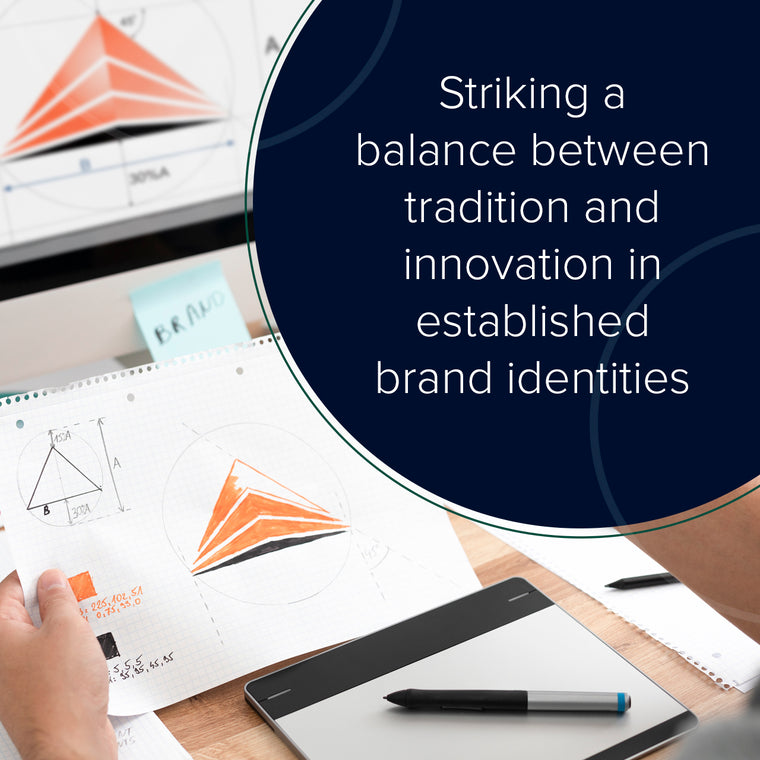Striking a Balance Between Tradition and Innovation in Established Brand Identities
Established brands face a unique challenge: balancing the core values and familiarity that have defined them for years with the need to adapt in a rapidly changing market.

Striking this balance between tradition and innovation in brand identities is not just an art, but a nuanced strategy. It requires a deep respect for the past, coupled with an eager embrace of the future.
Established brands often derive considerable strength from their traditions. Their historical roots, time-tested values, and recognisable symbols are not just elements of their brand identity, they are the pillars of reliability and trust among consumers. Consider the iconic monogram of a renowned luxury fashion house or the classic formula of a globally beloved beverage. These elements are not mere aesthetics or recipes, they are time-honoured testaments to the brand’s identity. Tradition is not just a foundation, it’s the enduring narrative that tells a brand’s story in a way that resonates with consumers across generations.
Heritage as a Pillar
Many renowned brands skilfully leverage their rich history, transforming it from a mere background story into a cornerstone of their identity. Heritage is not just a chapter in their narrative, it's a fundamental aspect of their appeal that differentiates them in a saturated market. This heritage can manifest in various ways, from established design elements that become instantly recognisable to longstanding product formulations that evoke nostalgia and trust. Moreover, a commitment to craftsmanship, passed down through generations, often becomes a testament to quality that has withstood the test of time.
Brand Loyalty
Consumers often form deep, lasting connections with brands that have been part of their lives for years, if not decades. Nostalgia and familiarity are more than just sentiments, they breed a profound loyalty. Customers associate these brands with positive experiences and cherished memories, making this loyalty a powerful force. However, maintaining this loyalty requires more than resting on historical laurels. It involves continuous engagement and adapting to changing consumer needs while staying true to the brand's core values. For instance, brands like Nike have shown how evolving product lines, customer engagement strategies, and innovative marketing while retaining their core essence can strengthen loyalty. This adaptability becomes crucial in weathering industry changes and emerging challenges, turning loyalty into a brand's most valuable asset.
The Imperative of Innovation
While tradition offers stability and a sense of identity, innovation is the key to staying relevant in a constantly evolving marketplace. Adapting to new technologies, shifting consumer preferences, and emerging trends is not just beneficial but essential for a brand’s longevity. However, embracing innovation is not about abandoning one's roots. It’s about evolving with a strategic vision that aligns new ideas with the brand's core values and history. For example, brands like Tiffany & Co have shown how integrating cutting-edge technology or embracing new market trends can be done without losing their traditional appeal. This approach ensures that while the brand remains dynamic and forward-looking, it still resonates with its loyal customer base who value its historical identity.
Adaptation to Modern Trends
Successful brands understand the importance of integrating modern trends, doing so in a way that complements rather than compromises their core identity. This adaptation can take various forms. Redesigning packaging, for instance, can refresh a brand’s visual appeal while maintaining its recognisable features. Adopting sustainable practices addresses growing consumer consciousness about environmental impact, aligning the brand with contemporary values. Moreover, leveraging social media platforms opens up avenues to connect with a new generation of consumers, engaging them with content that resonates with their digital-first lifestyle. Brands such as Lego and Disney demonstrate how these adaptations, when executed thoughtfully, can rejuvenate a brand's image and broaden its appeal without losing the essence of what made them successful in the first place.
Evolution, Not Revolution
The key to balancing tradition with innovation lies in evolution rather than revolution. This nuanced approach is about identifying and preserving the timeless elements that are the bedrock of a brand's identity while carefully integrating new innovations. It's akin to renovating a classic building - updating the infrastructure with modern amenities while preserving its historical architecture. Brands need to assess which aspects of their identity resonate most deeply with their audience and which areas are ripe for innovation. For example, Netflix have successfully evolved by adopting new technologies or trends in a way that complements their long-established brand ethos. This selective integration ensures that while the brand stays current and relevant, it does not lose the essence that has earned it customer loyalty and trust over the years.
Consumer Involvement
Engaging consumers in a brand’s evolutionary journey fosters a sense of inclusivity and belonging. This involvement can take many forms. Brands can seek direct feedback through surveys or focus groups, giving customers a voice in shaping future products or services. Social media platforms offer another avenue for engagement, allowing for real-time interaction and participation in brand narratives. For instance, inviting consumers to vote on new product designs or contribute ideas for a rebrand can transform them from passive buyers to active participants in the brand's story. This not only enhances the relevance of the brand but also builds a deeper sense of loyalty and connection.
Conclusion
In the complex interplay of tradition and innovation, established brands face the challenging yet rewarding task of evolving while preserving their essence. As we’ve explored, this balancing act involves not just a mere nod to the past but a strategic intertwining of heritage with contemporary trends and technologies. The essence of a successful brand evolution lies in recognising the timeless aspects of one’s brand identity and integrating innovations that resonate with both loyal and new customers. It is about engaging with consumers as active participants in the brand's journey, creating a narrative that is both inclusive and forward-looking. Brands that master this delicate balance are not only able to maintain their relevance but also strengthen their connection with a diverse and ever-changing marketplace. As the business landscape continues to evolve, the brands that thrive will be those that skilfully blend the richness of their legacy with the vibrancy of innovation, ensuring they remain not just recognisable, but also relatable and relevant in the eyes of their consumers.
How Absolute Design Can Help
At Absolute Design, Nottingham's premier branding agency, we're passionate about helping businesses like yours maintain and enhance brand consistency across all channels.
Our team of experts specialises in crafting tailored branding strategies that align with your unique goals and audience. We understand the challenges and opportunities that come with a consistent brand strategy, and we're here to empower your brand to stand out in the market.
Ready to elevate your brand with a blend of tradition and innovation?

